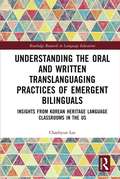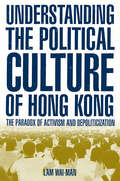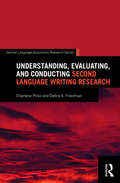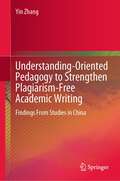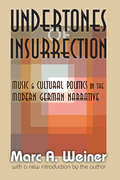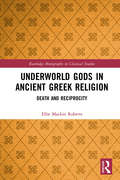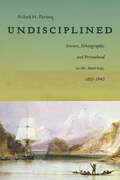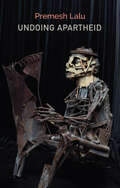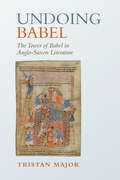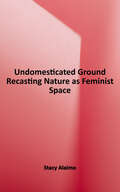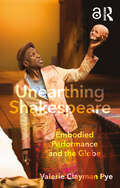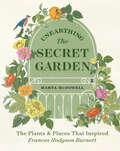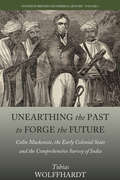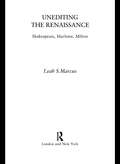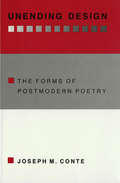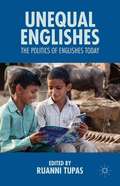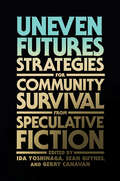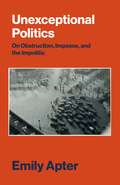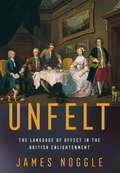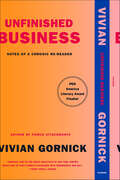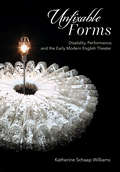- Table View
- List View
Understanding the Oral and Written Translanguaging Practices of Emergent Bilinguals: Insights from Korean Heritage Language Classrooms in the US (Routledge Research in Language Education)
by Chaehyun LeeDetailing qualitative research undertaken with elementary-grade children in a Korean heritage language school in the US, this text provides unique insight into the translanguaging practices and preferences of young, emergent bilinguals in a minority language group. Understanding the Oral and Written Translanguaging Practices of Emergent Bilinguals examines the role of socio-cultural influences on emergent bilinguals’ language use and development. Particular attention is paid to the role of immigrant parental involvement and engagement in their bilingual children’s language learning and academic performance. Presenting data from classroom audio recordings, writing, and drawing samples, as well as semi-structured interviews with children and parents, the book identifies important implications for the education of emergent bilinguals to better support their overall language and literacy development. This text will primarily be of interest to doctoral students, researchers, and scholars with an interest in bilingual education, biliteracy, and early literacy development more broadly. Those interested in applied linguistics, the Korean language, and multicultural education will also benefit from this volume.
Understanding the Political Culture of Hong Kong: The Paradox of Activism and Depoliticization (Asia And The Pacific/hong Kong Becoming China Ser.)
by Lam Wai-manThis book challenges the widely held belief that Hong Kong's political culture is one of indifference. The term "political indifference" is used to suggest the apathy, naivete, passivity, and utilitarianism of Hong Kong's people toward political life. Taking a broad historical look at political participation in the former colony, Wai-man Lam argues that this is not a valid view and demonstrates Hong Kong's significant political activism in thirteen selected case studies covering 1949 through the present. Through in-depth analysis of these cases she provides a new understanding of the nature of Hong Kong politics, which can be described as a combination of political activism and a culture of depoliticization.
Understanding, Evaluating, and Conducting Second Language Writing Research (Second Language Acquisition Research Series)
by Charlene Polio Debra A. FriedmanUnderstanding, Evaluating, and Conducting Second Language Writing Research speaks to the rapidly growing area of second language writing by providing a uniquely balanced approach to L2 writing research. While other books favor either a qualitative or quantitative approach to second language acquisition (SLA) research, this text is comprehensive in scope and does not privilege one approach over the other, illuminating the strengths of each and the ways in which they might complement each other. It also provides equal weight to the cognitive and socio-cultural approaches to SLA. Containing an array of focal studies and suggestions for further reading, this text is the ideal resource for students beginning to conduct L2 writing research as well as for more experienced researchers who wish to expand their approach to conducting research.
Understanding-Oriented Pedagogy to Strengthen Plagiarism-Free Academic Writing: Findings From Studies in China
by Yin ZhangThis book discusses the plagiarism-free academic writing in higher education. It demonstrates how to orchestrate an understanding-oriented pedagogy (including the teaching of plagiarism and source use) in order to facilitate plagiarism-free academic writing among undergraduates by revealing studies in China. This book emphasizes that plagiarism is a mere symptom of educational problems and plagiarism urgently needs education-based solutions instead of punish solutions. It highlights that students' meaningful understandings of plagiarism and source use should be identified as the main learning objectives of plagiarism instruction, as well as features the adoption of plagiarism instruction in academic writing practices in subject courses. It also focuses on the potentials of Information and Communication Technology (ICT) in scaffolding learning and teaching under plagiarism pedagogy beyond merely detecting plagiarism. This book also contributes to the discussion about the validity of current plagiarism assessment scales by providing evidences to challenge them and proposing a new one. This book is of great benefits for readers to increase knowledge and promote positive attitudes toward plagiarism and plagiarism instruction. It adds to our knowledge of how plagiarism in higher education can be effectively prevented by adopting an understanding-oriented pedagogy. It also adds to our knowledge of how Chinese undergraduates and their instructors view plagiarism and cope with plagiarism in discipline-based courses, which provides robust evidence for the academic debate about whether culture has effects on students’ plagiarism in academic writing. Finally, it provides insights about the relationship among plagiarism, pedagogy, and technology.
Undertones of Insurrection: Music and Cultural Politics in the Modern German Narrative
by Marc WeinerA basic tenet of literary studies is that aesthetic structures are politically significant because they represent an artist's response to the political implications of cultural codes with which the recipient of the modern work is also acquainted. This tenet provides the basis for the ideological associations attending the appearance of music in the modern German narrative. With his understanding of the arts as involved in often unacknowledged ideological forces within a culture, Marc Weiner's Undertones of Insurrection bridges the gap between the "New Musicology's" rewarding infusion of modern cultural and literary theory into the study of music, politically insightful examinations of narrative structures in the modern novel, and the methodologically conservative area of musical-literary relations in Germanic Studies. In other words, the questions it raises are different from those pursued in most examinations of music and literature, because previous works of this kind concerning the literature of German-speaking Europe have often disregarded social concerns in general, and political issues in particular.Ranging from 1900 to Doctor Faustus (1947), Weiner study sets the stage by examining public debates that conflated such issues as national identity, racism, populism, the role of the sexes, and xenophobia with musical texts. In the literary analyses that follow, Weiner discusses both obvious connections between music and sociopolitical issues--Hesse's equation of jazz and insurrection in Steppenwolf--and covert ones, the suppression of music in Death in Venice and the use of politically charged musical subtexts in Werfel's Verdi and Schnitzler's Rhapsody. By uncovering the ideological agendas informing cultural practice in modernist Germany, Undertones of Insurrection calls for a reevaluation of the function of music in the modern German narrative.
Underworld Gods in Ancient Greek Religion: Death and Reciprocity (Routledge Monographs in Classical Studies)
by Ellie Mackin RobertsThis volume presents a case for how and why people in archaic and classical Greece worshipped Underworld gods. These gods are often portrayed as malevolent and transgressive, giving an impression that ancient worshippers derived little or no benefit from developing ongoing relationships with them. In this book, the first book-length study that focuses on Underworld gods as an integral part of the religious landscape of the period, Mackin Roberts challenges this view and shows that Underworld gods are, in many cases, approached and ‘befriended’ in the same way as any other kind of god. Underworld Gods in Ancient Greek Religion provides a fascinating insight into the worship of these deities, and will be of interest to anyone working on ancient Greek religion and cult.
Undisciplined: Science, Ethnography, and Personhood in the Americas, 1830-1940 (America and the Long 19th Century #9)
by Nihad FarooqIn the 19th century, personhood was a term of regulation and discipline in which slaves, criminals, and others, could be “made and unmade." Yet it was precisely the fraught, uncontainable nature of personhood that necessitated its constant legislation, wherein its meaning could be both contested and controlled.Examining scientific and literary narratives, Nihad M. Farooq’s Undisciplined encourages an alternative consideration of personhood, one that emerges from evolutionary and ethnographic discourse. Moving chronologically from 1830 to 1940, Farooq explores the scientific and cultural entanglements of Atlantic travelers in and beyond the Darwin era, and invites us to attend more closely to the consequences of mobility and contact on disciplines and persons. Bringing together an innovative group of readings—from field journals, diaries, letters, and testimonies to novels, stage plays, and audio recordings—Farooq advocates for a reconsideration of science, personhood, and the priority of race for the field of American studies. Whether expressed as narratives of acculturation, or as acts of resistance against the camera, the pen, or the shackle, these stories of the studied subjects of the Atlantic world add a new chapter to debates about personhood and disciplinarity in this era that actively challenged legal, social, and scientific categorizations.
Undoing Apartheid (Critical South)
by Premesh LaluPost-apartheid South Africa still struggles to overcome the past, not just because the material conditions of apartheid linger but because the intellectual conditions it created have not been thoroughly dismantled. The system of &‘petty apartheid&’, which controlled the minutia of everyday life, became a means of dragooning human beings into adapting to increasingly mechanized forms of life that stifle desire and creative endeavour. As a result, apartheid is incessantly repeated in the struggle to move beyond it. In Undoing Apartheid, Premesh Lalu argues that only an aesthetic education can lead to a future beyond apartheid. To find ways to escape the vicious cycle, he traces the patterns created by three theatrical works by William Kentridge, Jane Taylor, and the Handspring Puppet Company – Faustus in Africa, Woyzeck on the Highveld, and Ubu and the Truth Commission – which coincided with the fall of the Berlin Wall and the end of apartheid. Through the analysis of these works, Lalu uncovers the roots of modern thinking about race and affirms the need to revitalize a post-apartheid reconciliation endowed with truth – if only to keep alive the rhyme of hope and history.
Undoing Babel: The Tower of Babel in Anglo-Saxon Literature (Toronto Anglo-Saxon Series)
by Tristan MajorThe Tower of Babel narrative is one of the most memorable accounts of the Bible, and its interpretative potential has produced a vast array of literary adaptations. Undoing Babel is the first extensive examination of the development of the Babel narrative amongst Anglo-Saxon authors from late antiquity to the eleventh century. Tristan Major’s illuminating and original insight into Anglo-Latin and Old English works, including the writings of Aldhelm, Bede, Alcuin, Ælfric, and Wulfstan, reveals the cultural ideologies and anxieties that transformed the Babel narrative. In doing so, Major argues that these Babel narratives provide a basis for understanding the world’s ethnic and linguistic diversity as well as a theological stimulus to evangelize non-Christian and non-European people. Undoing Babel highlights the depth of literary innovation in this period and disproves any notion of a single Anglo-Saxon reception of biblical sources.
Undoing the Digital: Sociomaterialism and Literacy Education (Literacies)
by Cathy Burnett Guy MerchantUndoing the Digital challenges common ways of understanding digital technology and its relationships to literacy and literacy education. The book explores how a sociomaterial perspective can provide an alternative analysis of literacy in the context of digital communication. Introducing a series of conceptual tools and examples, the book examines digital communication as an emergent interweaving of social, material and semiotic resources. The perspective invites literacy research to focus more on the relations associated with the process of making meaning: the new collaborations, stories, conceptualisations, directions, and intentions that take shape in, and also help to shape, the contemporary mediascape. Drawing on studies conducted in a variety of contexts, this book is key reading for all advanced students and researchers of literacy and digital media within Education, Applied Linguistics and Media/Communication Studies.
Undomesticated Ground: Recasting Nature As Feminist Space
by Stacy AlaimoFrom "Mother Earth" to "Mother Nature," women have for centuries been associated with nature. Feminists, troubled by the way in which such representations show women controlled by powerful natural forces and confined to domestic space, have sought to distance themselves from nature. In Undomesticated Ground, Stacy Alaimo issues a bold call to reclaim nature as a feminist space. Her analysis of a remarkable range of feminist writings-as well as of popular journalism, visual arts, television, and film-powerfully demonstrates that nature has been and continues to be an essential concept for feminist theory and practice. Alaimo urges feminist theorists to rethink the concept of nature by probing the vastly different meanings that it carries. She discusses its significance for Americans engaged in social and political struggles from, for example, the "Indian Wars" of the early nineteenth century, to the birth control movement in the 1920s, to contemporary battles against racism and heterosexism. Reading works by Catherine Sedgwick, Mary Austin, Emma Goldman, Nella Larson, Donna Haraway, Toni Morrison, and others, Alaimo finds that some of these writers strategically invoke nature for feminist purposes while others cast nature as a postmodern agent of resistance in the service of both environmentalism and the women's movement. By examining the importance of nature within literary and political texts, this book greatly expands the parameters of the nature writing genre and establishes nature as a crucial site for the cultural work of feminism.
Unearthing Shakespeare: Embodied Performance and the Globe
by Valerie Clayman PyeWhat can the Globe Theatre tell us about performing Shakespeare? Unearthing Shakespeare is the first book to consider what the Globe, today’s replica of Shakespeare’s theatre, can contribute to a practical understanding of Shakespeare’s plays. Valerie Clayman Pye reconsiders the material evidence of Early Modern theatre-making, presenting clear, accessible discussions of historical theatre practice; stages and staging; and the relationship between actor and audience. She relays this into a series of training exercises for actors at all levels. From "Shakesball" and "Telescoping" to Elliptical Energy Training and The Radiating Box, this is a rich set of resources for anyone looking to tackle Shakespeare with authenticity and confidence.
Unearthing Shakespeare: Embodied Performance and the Globe
by Valerie Clayman PyeWhat can the Globe Theatre tell us about performing Shakespeare?Unearthing Shakespeare is the first book to consider what the Globe, today’s replica of Shakespeare’s theatre, can contribute to a practical understanding of Shakespeare’s plays. Valerie Clayman Pye reconsiders the material evidence of Early Modern theatre-making, presenting clear, accessible discussions of historical theatre practice; stages and staging; and the relationship between actor and audience. She relays this into a series of training exercises for actors at all levels.From "Shakesball" and "Telescoping" to Elliptical Energy Training and The Radiating Box, this is a rich set of resources for anyone looking to tackle Shakespeare with authenticity and confidence.The Open Access version of this book, available at http://www.taylorfrancis.com, has been made available under a Creative Commons Attribution-Non Commercial-No Derivatives (CC-BY-NC-ND) 4.0 license.
Unearthing The Secret Garden: The Plants and Places That Inspired Frances Hodgson Burnett
by Marta McDowell&“Blooming with photos, illustrations, and botanical paintings, McDowell&’s gorgeous book opens an ivy-covered door to new information about one of the world&’s most famous authors.&”—Angelica Shirley Carpenter, editor of In the GardenNew York Times bestselling author Marta McDowell has revealed the way that plants have stirred some of our most cherished authors, including Beatrix Potter, Emily Dickinson, and Laura Ingalls Wilder. In her latest, she shares a moving account of how gardening deeply inspired Frances Hodgson Burnett, the author of the beloved children's classic The Secret Garden. In Unearthing The Secret Garden, McDowell delves into the professional and gardening life of Frances Hodgson Burnett. Complementing her fascinating account with charming period photographs and illustrations, McDowell paints an unforgettable portrait of a great artist and reminds us why The Secret Garden continues to touch readers after more than a century. This deeply moving and gift-worthy book is a must-read for fans of The Secret Garden and anyone who loves the story behind the story.
Unearthing the Changes: Recently Discovered Manuscripts of the Yi Jing (I Ching) and Related Texts (Translations from the Asian Classics)
by Edward L. ShaughnessyIn recent years, three ancient manuscripts relating to the Yi jing (I Ching), or Classic of Changes, have been discovered. The earliest—the Shanghai Museum Zhou Yi—dates to about 300 B.C.E. and shows evidence of the text's original circulation. The Guicang, or Returning to Be Stored, reflects another ancient Chinese divination tradition based on hexagrams similar to those of the Yi jing. In 1993, two manuscripts were found in a third-century B.C.E. tomb at Wangjiatai that contain almost exact parallels to the Guicang's early quotations, supplying new information on the performance of early Chinese divination. Finally, the Fuyang Zhou Yi was excavated from the tomb of Xia Hou Zao, lord of Ruyin, who died in 165 B.C.E. Each line of this classic is followed by one or more generic prognostications similar to phrases found in the Yi jing, indicating exciting new ways the text was produced and used in the interpretation of divinations. Unearthing the Changes details the discovery and significance of the Shanghai Museum Zhou Yi, the Wangjiatai Guicang, and the Fuyang Zhou Yi, including full translations of the texts and additional evidence constructing a new narrative of the Yi jing's writing and transmission in the first millennium B.C.E. An introduction situates the role of archaeology in the modern attempt to understand the Classic of Changes. By showing how the text emerged out of a popular tradition of divination, these newly unearthed manuscripts reveal an important religious dimension to its evolution.
Unearthing the Past to Forge the Future: Colin Mackenzie, the Early Colonial State, and the Comprehensive Survey of India
by Tobias WolffhardtFor much of the eighteenth and nineteenth centuries, the British East India Company consolidated its rule over India, evolving from a trading venture to a colonial administrative force. Yet its territorial gains far outpaced its understanding of the region and the people who lived there, and its desperate efforts to gain knowledge of the area led to the 1815 appointment of army officer Colin Mackenzie as the first Surveyor General of India. This volume carefully reconstructs the life and career of Mackenzie, showing how the massive survey of India that he undertook became one of the most spectacular and wide-ranging knowledge production initiatives in British colonial history.
Unediting the Renaissance: Shakespeare, Marlowe and Milton
by Leah MarcusUnediting the Renaissance is a path-breaking and timely look at the issues of the textual editing of Renaissance works. Both erudite and accessible, it will be a fascinating and provocative read for any Renaissance student or scholar. Leah Marcus argues that `bad' versions of Renaissance texts such as Shakespeare's First Folio should not be viewed as mutilated copies of originals, but rather reputable alternatives encoding differences in ideology, cultural meaning and other elements of performance. Marcus focuses on key Renaissance works- Dr Faustus, The Merry Wives of Windsor, The Taming of the Shrew, Hamlet and poems by Milton, Donne and Herrick - to re-exmaine how editorial intervention shapes the texts which are widely accepted as `definitive'. Examining the cultural attitudes, fears and influences which influence textual editors, from the seveteenth century to the present day, Marcus sheds new light on a previously unexamined aspect of Renaissance studies. A lively critique of current theoretical practices, Unediting the Renaissance will shift the ways in which Shakespeare and his contemporaries are edited and read.
Unending Design: The Forms of Postmodern Poetry
by Joseph M. ConteDrawing on the work of contemporary American poets from Ashbery to Zukofsky, Joseph M. Conte elaborates an innovative typology of postmodern poetic forms. In Conte's view, looking at recent poetry in terms of the complementary methods of seriality and proceduralism offers a rewarding alternative to the familiar analytic dichotomy of "open" and "closed" forms.
Unequal Englishes
by Ruanni TupasUnequal Englishes challenges the widely held assumption that languages and linguistic varieties are equal, and explores the various ways we can understand, examine and transform inequalities of Englishes. Written by engaging and well-known scholars of language, education and politics, the chapters in the volume offer a wide range of perspectives on the complex but interwoven relationships between inequalities and Englishes, with an expansive geopolitical trajectory which includes the Philippines, Cuba, China, Canada, India, Malaysia, the United States, Singapore and South Korea. Their specific social and ideological contexts of analyses are wide-ranging, including textbooks and classrooms; teachers, would-be teachers and students; call centers; linguistic landscapes; stories, narratives and jokes. The volume mobilizes the notion of unequal Englishes as one way to understand the global spread of English today.
Uneven Futures: Strategies for Community Survival from Speculative Fiction
by Gerry Canavan Sean Guynes Ida YoshinagaEssays on speculative/science fiction explore the futures that feed our most cherished fantasies and terrifying nightmares, while helping diverse communities devise new survival strategies for a tough millennium.The explosion in speculative/science fiction (SF) across different media from the late twentieth century to the present has compelled those in the field of SF studies to rethink the community&’s identity, orientation, and stakes. In this edited collection, more than forty writers, critics, game designers, scholars, and activists explore core SF texts, with an eye toward a future in which corporations dominate both the means of production and the means of distribution and governments rely on powerful surveillance and carceral technologies. The essays, international in scope, demonstrate the diversity of SF through a balance of popular mass-market novels, comics, films, games, TV shows, creepypastas, and more niche works. SF works explored range from Riot Baby by Tochi Onyebuchi, 2084: The End of the World by Boualem Sansal, Terra Nullius by Claire Coleman, Watchmen and X-Men comics, and the Marvel film Captain America: The Winter Soldier, to the MaddAddam trilogy by Margaret Atwood, The Dispossessed by Ursula K. Le Guin, The Wandering Earth by Liu Cixin, and the Wormwood trilogy by Tade Thompson. In an era in which ecological disaster and global pandemics regularly expose and intensify deep political-economic inequalities, what futures has SF anticipated? What survival strategies has it provided us? Can it help us to deal with, and grow beyond, the inequalities and injustices of our times? Unlike other books of speculative/science fiction criticism, Uneven Futures uses a think piece format to make its critical insights engaging to a wide audience. The essays inspire visions of better possible futures—drawing on feminist, queer, and global speculative engagements with Indigenous, Latinx, and Afro- and African futurisms—while imparting important lessons for political organizing in the present.Contributors: Ben Abraham, Emmet Asher-Perrin, Brent Ryan Bellamy, Gerry Canavan, Andrew Ferguson, Fabio Fernandes, Dexter Gabriel, M. Elizabeth Ginway, Sean Guynes, Ouissal Harize, David M. Higgins, Veronica Hollinger, Allanah Hunt, Nicola Hunte, Nathaniel Isaacson, Ayana Jamieson, Darshana Jayemanne, Gwyneth Jones, Brendan Keogh, Sami Ahmad Khan, Cameron Kunzelman, Bryan Kamaoli Kuwada, Isiah Lavender III, Caryn Lesuma, Karen Lord, Sarah Marrs, Farah Mendlesohn, Cathryn Merla-Watson, Hugh Charles O&’Connell, B. Pladek, John Rieder, Lysa Rivera, Kim Stanley Robinson, Steven Shaviro, Rebekah Sheldon, Alison Sperling, Alfredo Suppia, Bogi Takács, Taryne Jade Taylor, Sherryl Vint, Kirin Wachter-Grene, Ida Yoshinaga.
Unexceptional Politics: On Obstruction, Impasse, and the Impolitic
by Emily ApterA new vision of politics “below the radar”One way to grasp the nature of politics is to understand the key terms in which it is discussed. Unexceptional Politics develops a political vocabulary drawn from a wide range of media (political fiction, art, film, and TV), highlighting the scams, imbroglios, information trafficking, brinkmanship, and parliamentary procedures that obstruct and block progressive politics. The book reviews and renews modes of thinking about micropolitics that counter notions of the “state of exception” embedded in theories of the “political” from Thomas Hobbes to Carl Schmitt. Emily Apter develops a critical model of politics behind the scenes, a politics that operates outside the norms of classical political theory. She focuses on micropolitics, defined as small events, happening in series, that often pass unnoticed yet disturb and interfere with the institutional structures of capitalist parliamentary systems, even as they secure their reproduction and longevity. Apter’s experimental glossary is arranged under headings that look at the apparently incidental, immaterial, and increasingly virtual practices of politicking: “obstruction,” “obstinacy,” “psychopolitics,” “managed life,” “serial politics.” Such terms frame an argument for taking stock of the realization that we really do not know what politics is, where it begins and ends, or how its micro-events should be described.
Unfelt: The Language of Affect in the British Enlightenment
by James NoggleUnfelt offers a new account of feeling during the British Enlightenment, finding that the passions and sentiments long considered as preoccupations of the era depend on a potent insensibility, the secret emergence of pronounced emotions that only become apparent with time. Surveying a range of affects including primary sensation, love and self-love, greed, happiness, and patriotic ardor, James Noggle explores literary evocations of imperceptibility and unfeeling that pervade and support the period's understanding of sensibility.Each of the four sections of Unfelt—on philosophy, the novel, historiography, and political economy—charts the development of these idioms from early in the long eighteenth century to their culmination in the age of sensibility. From Locke to Eliza Haywood, Henry Fielding, and Frances Burney, and from Dudley North to Hume and Adam Smith, Noggle's exploration of the insensible dramatically expands the scope of affect in the period's writing and thought.Drawing inspiration from contemporary affect theory, Noggle charts how feeling and unfeeling flow and feed back into each other, identifying emotional dynamics at their most elusive and powerful: the potential, the incipient, the emergent, the virtual.
Unfinished Business: Notes of a Chronic Re-reader
by Vivian GornickA New York Times Book Review Editors' Choice. One of Library Journal's Best Books of 2020. One of our most beloved writers reassess the electrifying works of literature that have shaped her lifeI sometimes think I was born reading . . . I can’t remember the time when I didn’t have a book in my hands, my head lost to the world around me.Unfinished Business: Notes of a Chronic Re-reader is Vivian Gornick’s celebration of passionate reading, of returning again and again to the books that have shaped her at crucial points in her life. In nine essays that traverse literary criticism, memoir, and biography, one of our most celebrated critics writes about the importance of reading—and re-reading—as life progresses. Gornick finds herself in contradictory characters within D. H. Lawrence’s Sons and Lovers, assesses womanhood in Colette’s The Vagabond and The Shackle, and considers the veracity of memory in Marguerite Duras’s The Lover. She revisits Great War novels by J. L. Carr and Pat Barker, uncovers the psychological complexity of Elizabeth Bowen’s prose, and soaks in Natalia Ginzburg, “a writer whose work has often made me love life more.” After adopting two cats, whose erratic behavior she finds vexing, she discovers Doris Lessing’s Particularly Cats. Guided by Gornick’s trademark verve and insight, Unfinished Business is a masterful appreciation of literature’s power to illuminate our lives from a peerless writer and thinker who “still read[s] to feel the power of Life with a capital L.”
Unfinished Spirit: Muriel Rukeyser's Twentieth Century
by Rowena Kennedy-EpsteinIn Unfinished Spirit, Rowena Kennedy-Epstein brings to light the extraordinary archive of Muriel Rukeyser's (1913–1980) unpublished and incomplete literary works, revealing the ways in which misogyny influences the kinds of texts we read and value. Despite her status today as an influential poet, much of Rukeyser's critical and feminist writing remained unfinished, suppressed by the sexism of editors, political censure, the withdrawal of funding and publishing contracts, as well the conditions of single motherhood and economic precarity.From Savage Coast, her novel of the Spanish Civil War (which Kennedy-Epstein recovered, edited, and published to great acclaim in 2013) to her photo-text collaboration with Berenice Abbott, essays on women writers, radio scripts, and biographies, Unfinished Spirit traces the creation, reception, and rejection of Rukeyser's most ambitious texts—works that continued the radical, avant-garde project of modernism and challenged an increasingly hegemonic Cold War culture. Bound together by Rukeyser's radical vision of artistic creation and political engagement, these incomplete texts open a space to theorize the politics of the unfinished for understanding women's artistic production, reasserting the importance of the archive as a primary site of feminist criticism.
Unfixable Forms: Disability, Performance, and the Early Modern English Theater
by Katherine Schaap WilliamsUnfixable Forms explores how theatrical form remakes—and is in turn remade by—early modern disability. Figures described as "deformed," "lame," "crippled," "ugly," "sick," and "monstrous" crowd the stage in English drama of the sixteenth and seventeenth centuries. In each case, such a description distills cultural expectations about how a body should look and what a body should do—yet, crucially, demands the actor's embodied performance. In the early modern theater, concepts of disability collide with the deforming, vulnerable body of the actor. Reading dramatic texts alongside a diverse array of sources, ranging from physic manuals to philosophical essays to monster pamphlets, Katherine Schaap Williams excavates an archive of formal innovation to argue that disability is at the heart of the early modern theater's exploration of what it means to put the body of an actor on the stage. Offering new interpretations of canonical works by William Shakespeare, Ben Jonson, Thomas Dekker, Thomas Middleton, and William Rowley, and close readings of little-known plays such as The Fair Maid of the Exchange and A Larum For London, Williams demonstrates how disability cuts across foundational distinctions between nature and art, form and matter, and being and seeming. Situated at the intersections of early modern drama, disability studies, and performance theory, Unfixable Forms locates disability on the early modern stage as both a product of cultural constraints and a spark for performance's unsettling demands and electrifying eventfulness.
